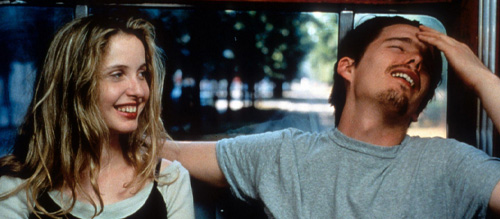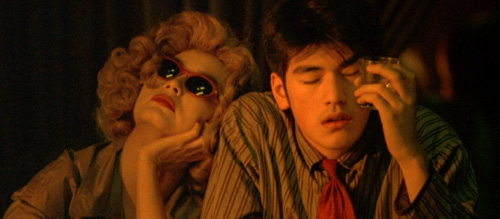What Film Can Teach Us About Heartbreak

Love in the Abstract: What Film Can Teach Us About Heartbreak
Films abide by a language, a collection of signals that guide the audience’s expectations, informing us of what to expect in hidden ways. A still shot implies calmness, control. Loud, pulsing music implies chaos or terror. Cues like these are often the reason people watch films in the first place – to escape into a story that is recognizable, but doesn’t remind them of their own personal troubles; one that is driven by logic and clarity, not by the chaos of everyday life.
At the same time, filmmakers are ideally trying to surprise us, show us something new, bring us along on some kind of emotional journey. Overuse these structural techniques and the audience gets too comfortable, the stories become too safe, and everything is spelled out on the surface. How do filmmakers strike a balance between rigid structure and genuine emotion? Is it a balance that needs to be struck?
Richard Linklater’s Before Sunrise (1995) depicts two strangers, Jesse (Ethan Hawke) and Celine (Julie Delpy), meeting on a train and falling in love over the course of a single evening. From the very first scene, we are strapped in with these characters; we witness them grow more comfortable with one another, admitting things they hid at first, and even offending each other before ultimately finding a way towards true connection. The film is straightforward, structured, and dialogue-driven, yet it still strikes on a deep emotional level. When these characters are forced to separate, we feel the same kind of nauseating uncertainty that they do. Clearly there is nothing wrong with this candid approach to storytelling, but there are also alternatives. Many filmmakers feel that to truly convey the complexity of relationships and romance, certain feelings can’t be translated solely through dialogue or realism. After all, falling in love is abstract, contradictory, ephemeral. It makes sense that stories representing that experience could be the same.

Wong Kar-wai’s Chungking Express (1994) consists of two distinct narratives, each centered around lovesick individuals searching for connection in the urban sprawl of Hong Kong. These characters’ experiences of longing is often represented through objects – He Qiwu (Takeshi Kaneshiro) thinks of canned pineapples as a symbol of his expiring relationship with his girlfriend, May. He then meets a drug smuggler (Brigitte Lin) in a bar, and despite their differences, they share an intimate evening discussing love. Later, when she falls asleep in their shared hotel room, he gorges himself on room service – food serves as temporary nourishment for his longing.
The second narrative centers around Cop 663 (Tony Leung), who handles his loneliness by talking to the objects in his apartment. After a breakup with a flight attendant, he meets Faye (Faye Wong) at a snack bar. She falls hopelessly in love with him, experiencing feelings so strong that her only way to handle them is to break into his apartment and occupy the same space, breathe the air he breathes, touch the objects he touches. The characters in this film act in unusual and sometimes disorienting ways. Many of the most important moments don’t come from the exchange of dialogue, but instead in the character’s actions, the way they move across the screen, the long glances they share. But this lack of explanation ultimately offers a more rewarding experience. The details Kar-wai includes linger in your mind, the emotions the characters exhibit feel truer, and he does this by operating outside of genre constructs.
Chungking Express’ dynamic, vibrant nature makes it hard to define by a single genre – instead it is a meld of them, with elements of crime, comedy, and drama all mixed in. Many standard dramas about love seem to follow very specific guidelines. Characters meet, they don’t get along, they reunite under new circumstances and find they have more in common than they thought. Characters cheat on each other, they get drunk, they wander through the city, lost. This isn’t to say that moments like this can’t be genuinely affecting, but something is lost when these genre signposts are overused – emotions become secondary to our expectations.

Eternal Sunshine of the Spotless Mind (2004) is a film about a man named Joel (Jim Carrey) who chooses to erase all memory of his ex-girlfriend, Clementine (Kate Winslet), finding it too painful to live with the leftovers of a relationship gone sour. Much of the narrative takes place inside Joel’s head, allowing us to experience these memories as they are erased, moments which are unconcerned with depicting life or memory with realism, but instead with mysticism and abstraction – the result is more honest, it cuts deeper. In one particular scene in which Joel’s memory is being erased, he watches helplessly as Clementine is dragged into the shadows by an invisible force. Horror elements work to show us what is happening to Joel – this tactic unlocks a more engaging visual experience, while also clearly conveying the emotions he’s experiencing. By employing the language of alternative genres, director Michel Gondry is able to create a more thrilling viewing experience.
By bending genre and focusing on imagery, these filmmakers are able to unlock a more subconscious form of storytelling – one that gets under the skin. Human emotions are complex, they cannot fit within genres, so why should we expect the art that depicts them to be so neat and tidy?
Maybe it’s true that most people don’t want to go into a film expecting comedy or romance and instead be met with horrifying images. But when our expectations become too tailored, we become overly familiar, and as a result, are no longer challenged by the art we consume. Walking into a theater, we always know what to expect. Any uncertainty we feel is temporary, and with it comes the subconscious reminder that it will all be sorted out in the end. By combining and employing tactics from other genres, these filmmakers are able to create an atmosphere of liveliness and unpredictability. Both of these films trade clear structure and narrative for impressions – images that stick with you long after you watch them, images that are carefully constructed to represent love in the abstract, even if they might not offer immediate clarity: a house where a couple first met overtaken by waves as they say goodbye. A woman drawing a plane ticket on a napkin, the destination left blank.
At the end of these stories, characters are still struggling for connection, still uncertain about their futures together. They feel like real people grappling with the contradictions of love – the audience is not sure if things will work out for them, but the films are still satisfying, because we leave having felt something. Films that abide by tropes can still succeed if they are made with honesty and truth, and if they communicate something deep. What matters is that these films have an emotional core, a relation to the human experience that the audience can connect with, can be surprised by. To say one filmmaking tactic is superior than the other would be an oversimplification. But it’s worth considering the limitations we place on ourselves when we have too many expectations, or require things to be spelled out too carefully. Films are an art form, a mode of communication for deep ideas and the experience of life.
Connection is something we all search for. It is essential to the human experience: feeling linked to another person, being able to understand them, having them understand you. But with this desire to connect comes contradictions. How can you grow to trust someone after being hurt before? How can you forgive someone who has let you down so many times? It is somewhat of a mystery. Love changes us – it makes us patient, forgiving, it leads us to decisions that might not make sense to others, because even though love is universal, each individual’s experience of it is deeply personal, a private world that can’t be conveyed to outsiders. These decisions or feelings don’t need to be justified. And your experience of a film doesn’t need to be either. Real life is often nonsensical and absurd – if art can truly mirror that experience, something special can occur. When we allow art to impress itself upon us and remove any prior assumptions before experiencing it, we just might walk away having felt something deeper.
Written by Sam Florsheim
You can support Sam Florsheim in the following places:
Instagram – @samflorsh
Website – samflorsheim.com

